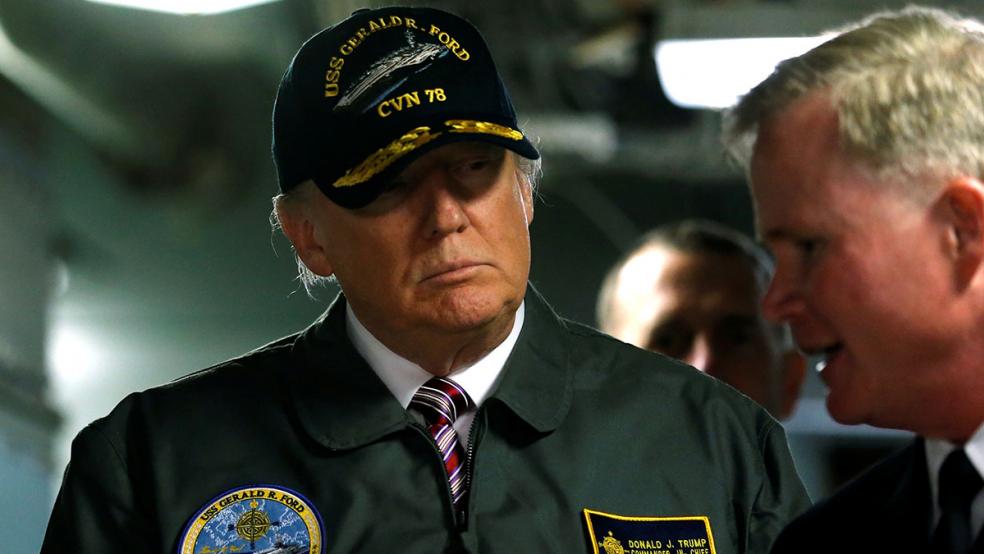During the election, both Bernie Sanders and Donald Trump rejected the image of America striding the globe with billy club in hand and portrayed Hillary Clinton as too quick on the trigger. At times, they almost seemed to be reading from the same political playbook.
Yes, Trump far more forcefully vowed to destroy ISIS and was not afraid to say the words “radical Islam.” But the two populists with distinct grass-roots movements repeatedly said that by playing global cop, the U.S. had blundered into disastrous foreign adventures.
Related: The US Navy’s $13 Billion Answer to China and Russia
Both routinely savaged Clinton for her vote as a senator to authorize military action in Iraq. And Trump came close to bringing primary rival Jeb Bush to tears by harping on what he said was former President George W. Bush’s devastating decision to chase ephemeral weapons of mass destruction and topple the regime of Saddam Hussein, leading the country into a bloody Middle East quagmire.
“We cannot be the policemen of the world,” Trump said at the first presidential debate. “We cannot protect countries all over the world.”
But that was then.
Now Sanders is back to being a progressive voice crying in the wilderness, Clinton is wandering around the wilderness (or at least around the parks near her home in suburban New York) and Trump is commander-in-chief of a military that is flexing its muscles around the globe.
In Yemen, as The Wall Street Journal reported on Monday, the Trump administration is ramping up support for Saudi Arabia and the United Arab Emirates in their fight “against al Qaeda and Iranian-backed militias … drawing the U.S. deeper into the two-year civil war there.”
Related: US Strikes in Libya Kill More Than 80 Islamic State Fighters
In Iraq, 300 troops from the Army’s 82nd Airborne Division are joining the battle to oust ISIS from its stronghold in Mosul, where some 2,000 fighters are embedded in the civilian population, according to Military Times. That pushes up the number of American soldiers in Iraq to more than 6,000, it said. On Mar. 17, as many as 200 civilians may have been killed by a U.S. airstrike, according to Foreign Policy.
In Syria, some 400 Marines began manning heavy artillery earlier this month in support of hundreds of U.S. Special Operations soldiers assisting Kurdish fighters and other ant-ISIS warriors trying to capture Raqqa, the so-called capital of the Islamic State.
In Libya, U.S. troops continue to monitor what is left of an Islamic State force decimated by B-2 bomber raids in January that attacked a desert encampment near the coastal city of Sirte, according to Stars and Stripes. Last week, Marine Gen. Thomas Waldhauser, chief of the U.S. Africa Command, said Special Operations teams would remain in the country for the foreseeable future.
In Somalia, drought and famine are complicating the fight against the terror group Al-Shabaab, Waldhauser told a press breakfast on Monday, but he also said last week that the military has asked the Trump administration for more “flexibility” on the rules of engagement with the al Qaeda-linked group, according to the website Military.com.
In Afghanistan, more troops may be needed for America’s longest military action, Gen. Joseph Votel, head of U.S. Central Command, said earlier this month, according to Foreign Policy. That would mark a reversal from a peak of about 100,000 troops six years ago to about 8,400 today.
Consumed by the investigation into Russian meddling in the U.S. election and allegations that the Trump campaign may have colluded with Moscow; embarrassed by a failed run at replacing Obamacare; and tripped up by all the predictable hurdles facing a young and inexperienced White House, the military-heavy administration seems to be giving the Pentagon considerably more leeway than it had in the Obama years.
Related: Trump Wants a Much Bigger Navy: Here’s How Much It’ll Cost
A lot of what looks like increased enemy engagement in all the hot spots mentioned above can be tied to Trump pledge to eradicate ISIS. But the thrust of the administration can also fairly be said to be more military involvement, not less.
The president has asked for almost $30 billion more in fiscal 2017 and $54 billion next year to rebuild the military and accelerate the fight against ISIS; he wants to expand the size of America’s fighting force, including 3,000 more Marines this year; and his plans call for a 350-ship Navy.
Even in Europe, which was unsettled during the campaign by Trump suggestions that other NATO countries weren’t pulling their weight, the Pentagon under Defense Secretary James Mattis, a former four-star Marine general, is showing the flag.
In January a contingent of about 300 Marines were deployed to Norway for six months – the first time since World War II – for training in an Arctic environment.
Also that month, 4,000 American soldiers landed in Poland to demonstrate what the U.S. ambassador to that country called “an iron-clad commitment” to NATO allies.
In the meantime, two months of war games continue in and around the Korean Peninsula, where tensions are high as North Korea angrily monitors almost 20,000 U.S. and 300,000 Republic of Korea troops engaging in joint exercises.
On Friday, Reuters reports, North Korea carried out a new test of a rocket engine that could be used in an intercontinental ballistic missile (ICBM) – part of a pattern of provocative behavior this month.
President Trump may not want to police the planet, but willingly or not, he is becoming the new U.S. cop on the beat.
The President has asked for almost $30 billion more in fiscal 2017 to rebuild the military and accelerate the fight against ISIS; he wants to expand the size of America’s fighting force, including 3,000 more Marines this year; and his future plans call for a 350-ship Navy.





